Better Together
The elements of paid & organic marketing
How to find and optimize your best combinations
By JOHN KOETSIER | TUNE
Every successful experiment starts with a hypothesis
Experience has proved the hypothesis that combining paid and organic marketing drives valuable synergies. We’ll show you how.
In the following pages, we’ll reveal proven approaches to boosting conversions on paid marketing and magnifying the impact of marketing spend on owned media. We’ll connect the dots between these benefits and more effective customer acquisition, higher-quality performance advertising, better retention for brand marketing, and more. And we’ll cover everything you need to run your own experiments and find the combinations of paid and organic that work best for your business.
First, a quick description of each. Earned and owned marketing is organic — in a sense, free. Paid marketing, as the name implies, requires cold, hard cash.
However, those simple divisions lose their clarity when put under the microscope. As leading marketers have discovered, organic and paid are better together, and some of the most powerful marketing happens when they combine. Here’s some of the hard data we’ll highlight in this report:
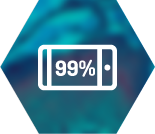
How paid mobile marketing can boost organic app installs up to 99%

How organic SEO coupled with paid ads can boost revenue up to 7X

How paid social ads plus organic SEO can drive “free” leads

How paid banner ads can boost organic SEO up to 10X
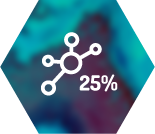
How organic relationship management has been shown to improve paid ad performance by 25%

How organic social plus paid social can increase social commerce by nearly 6X
This report contains data from hundreds of millions of paid clicks by marketers in SMB and enterprise companies, plus insights from over 50 marketers who have built campaigns for companies like Vodaphone, El Corte Inglés (the biggest retail group in Europe), top e-commerce sites, and some of the largest social and shopping apps in the United States.
Let’s get started.
The formula for success
The first step in any successful experiment is conducting background research. We recommend the following steps.
View mobile as an ecosystem
Marketers know that almost three quarters of our digital media time is spent on mobile devices, which have become the first source of both information and entertainment. This means that email is mobile. Web is mobile. Apps, video, and messaging are mobile. Our lives are mobile.
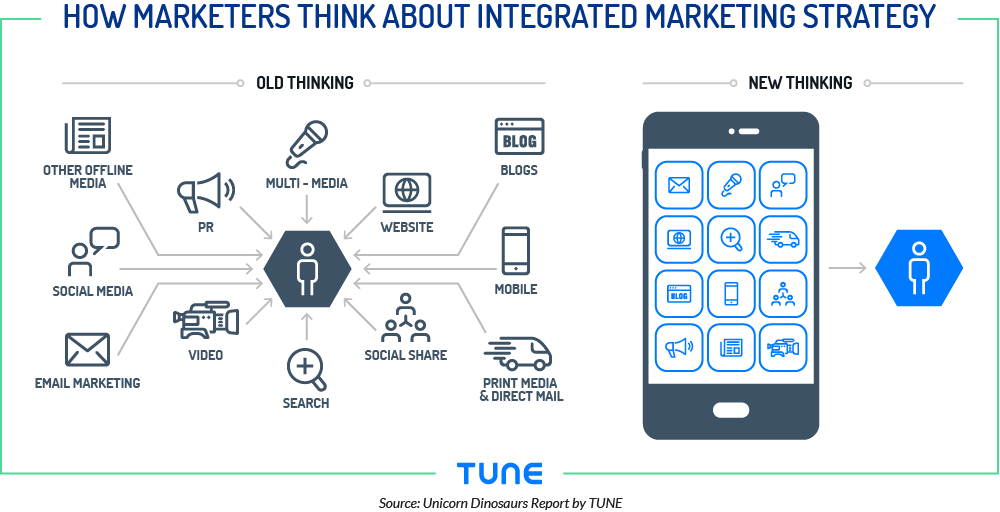
And that means mobile is not a channel. It is an ecosystem where other channels live.
With the modern mobile landscape in mind, it’s worth mapping how traditional owned, earned, and paid marketing channels fit in:
-
Pure Mobile
Apps, SMS, ASO, Podcasts
-
Mostly Mobile
Email, Web/SEM, Phone, Search/SEO, Social media, Video, Influencer marketing, Display/banner ads, Relationship management, Community building, Content marketing, Native advertising, Retargeting, Directories/guides
-
Mobile influenced
TV, PR, Magazines, Outdoor, Radio, In-store, Event marketing, Trade shows, Webinars, Loyalty programs, Affiliate marketing
-
Not mobile
Newspapers, Direct mail, Printed brochures, In-person sales, Signage, Billboards, Speaking events
Today, almost all marketing could be classified as mobile influenced. Why?
Because we always have our smartphones with us, everywhere we go. (Our phones are so much a part of us that anxiety resulting from forgetting one’s mobile device, nomophobia, has been proposed as a diagnosable psychological condition in the DSM-IV, the psychologists’ bible. Amber Case, a research fellow at MIT and a “cyber anthropologist,” has even suggested that smartphone-owning humans are essentially cyborgs.)
This means that even outdoor marketing like billboards are mobile influenced, as they prompt mobile searches and mobile calls. Radio ads are the same. Paper-based marketing and advertising like brochures, magazines, and newspapers usually have web or email addresses, the latter of which are now primarily accessed via mobile. Even live, in-person speaking events are mobile influenced: people snap photos of slides and speakers, take notes on their phones, or browse Twitter when bored.
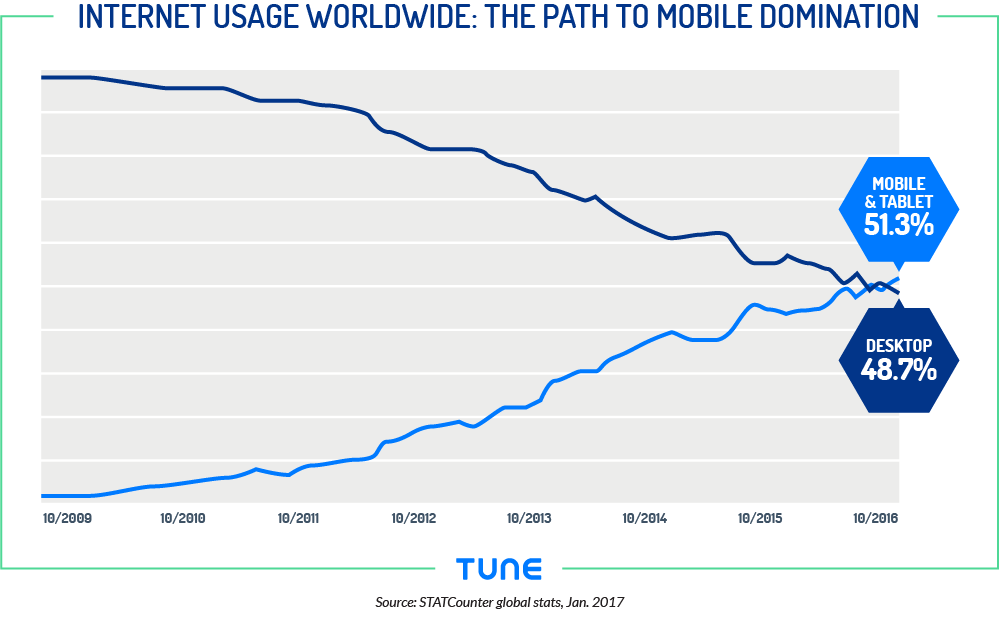
As Apple’s ARKit and Google’s ARCore make their way into more smart devices, everything physical will also begin to possess digital attributes, further unifying channels into a digital ecosystem.
Embrace the cutting edge
When brands understand and embrace the mobile future, we define them as MobileBest. More nuanced than mobile-first or mobile-only, MobileBest means understanding that mobile is now the primary interface between humans and the digital world and that the digital world is becoming a larger portion of our existence every year.
To date, relatively few companies have adopted this thinking:
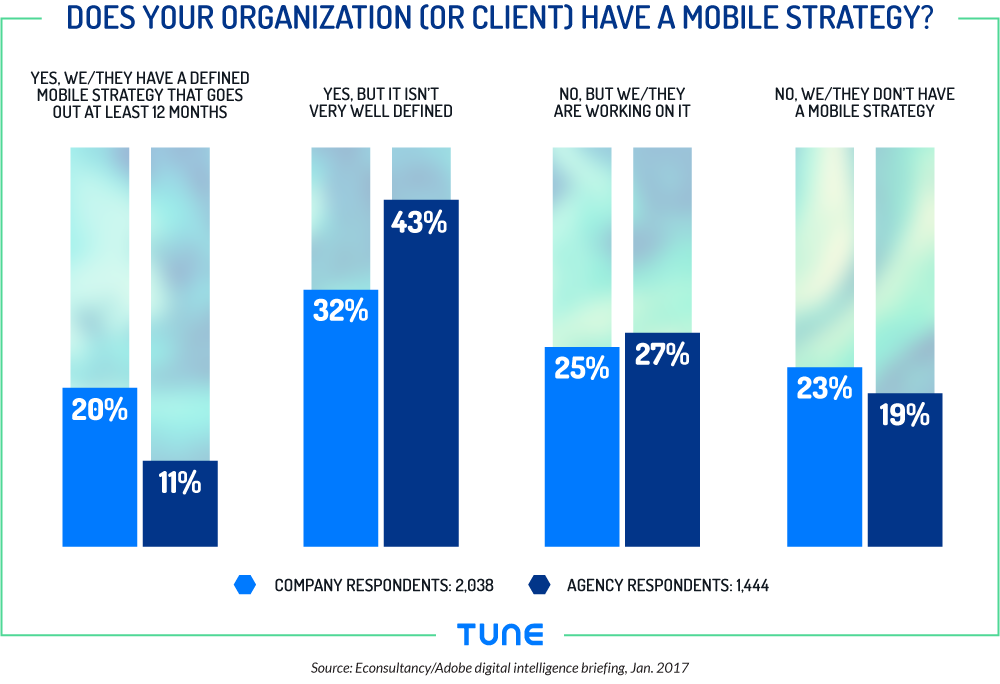
For marketers, MobileBest strategies represent a determination to meet customers where they are: to use apps where appropriate; mobile web where it makes sense; integrations into other mobile properties when opportunities present themselves; desktop when the task dictates; and other channels as customers demand. In short, MobileBest exemplifies the time-honored approach that what’s best for the customer is what’s best for the brand.
Adopt a MobileBest methodology
Successful mobile marketing is more than customer acquisition, performance advertising, or in-app marketing. It’s all of these things and more. This compounds the need to excel in mobile — and is why the effort of developing a true strategy for success is worth it.
MobileBest strategies also contribute to financial growth. (We know because we’ve done the math.)
Mobile leaders in the Fortune 1000 have grown market value 15% faster than mobile laggards in 2016. They’re also 1.9X more likely to be financially successful. That’s not just Apple, Google, Facebook, and Amazon. Caterpillar has 355,000 mobile-app-using customers; Exxon Mobil, over 400,000. And Home Depot has a massive 17.7 million.
By meeting customers when, where, and how they consume media, these companies have captured more value than their peer set and positioned themselves to do more of the same.
Define your variables: owned, earned, and paid media
Traditional definition = compartmentalized, or individual elements
The traditional definition of owned, earned, and paid is simplistic.

Owned:
websites, apps, and other properties that you own

Earned:
word of mouth, search ranking, social visibility, PR

Paid:
any media or exposure you buy
When considered as silos, the traditional definition doesn’t account for how complementary these channels should be.
Modern definition = blended, with compounding benefits
Today, paid, earned, and owned are mutually beneficial.
- Let’s say you own a website, through which you earn high search engine results via SEO strategies and are publishing strong content.
- Let’s also say you own an app, through which you generate engagement, earning more visibility as customers use and share it.
- You also own a Twitter handle with 5 million followers, or a Facebook page with 500,000 fans, through which you earn a respected voice by sharing information relevant to your audience.
That’s effective organic marketing. And combining it with paid marketing magnifies its impact.
- Let’s say your organic social is underperforming. To give it a jolt, you pay to juice a video in your owned channel and generate additional earned views, likes, and shares.
- Your app isn’t getting traction on Google Play, so you run customer acquisition campaigns. The paid acquisition boosts installs — a signal to potential customers that your app is popular.
- New and existing customers engage in your app as a result of onboarding strategies, push messaging, and in-app marketing — a signal to Google that your app deserves a higher search ranking.
The power of combining paid and organic marketing is clear when viewed through straightforward theoretical examples. When explored strategically and deployed with discipline, these synergistic combinations reveal opportunities to optimize customer acquisition, amplify brand equity, and maximize overall ROI. It just takes some testing and tweaking to get right.
How to experiment with paid and organic
Successful mobile marketing is finding the perfect formula
Historically, it’s been hard for marketers to assess how organic and paid media interact. Implicit knowledge that they do and that the interaction can be positive has encouraged thoughtful experiments and, once effective combinations are identified, improved ROI.
“Think of paid media as the quarterback and earned and owned as the offensive line,” offers Mike Gilloon, Director of Strategic Communications at Bozell. “Like paid media, the quarterback is very important and often gets most of the attention. But he’s not very effective without a strong offensive line.”
Gilloon’s experience illustrates Better Together at work. We’ll now dive into the underlying reactions and interactions that make the combination of paid and organic so powerful.
Theories of how paid marketing affects organic
Mixing paid with organic expands brand footprint and customer touchpoints (in other words, the umbrella under which your brand operates). The combination also creates new paths to customer acquisition and reveals the messages that resonate most powerfully.
Signaling factors and higher ranking
Because unknown brands are often perceived as risky, paid marketing can serve as a shortcut to building familiarity. Jason Parks, President of The Media Captain, says this is critical in building organic inquiries.
“Paid ads have been a big reason for the constant uptick in organic because people will hit our website, drop off, remember the brand name, then conduct an organic search … and convert,” he says.
Sometimes organic feeds organic too. “When you put a product on Amazon, it often populates on Google’s organic searches, which makes it synergistic,” Parks adds.
Retargeting (or remarketing) can build lasting relationships. It’s also valuable throughout the customer journey even if retargeted ads are not the final catalyst in customer acquisition, according to Shanti Shunn, a digital marketing strategist at Vizion Interactive.
“Remarketing is definitely a channel that, while it may not drive direct business, it may like social media continue to create a business to consumer or potential consumer relationship,” he says. “In that respect, display advertising can also work to reinforce other channels.”
Brand umbrellas
Digital marketplaces use signaling factors to identify consumer behavior and reflect trends in the form of top lists, bestsellers, and factors that build into organic placement.
Sales velocity is one signaling factor that’s especially important in the App Store and Google Play. “Any impact you have on driving quality velocity will help with organic ranking,” says Patrick Haig, Director of Product at TUNE.
Similar connections hold true in marketplaces like Amazon, as well as for Google and Bing search results, which are essentially marketplaces for answers. Additional volume driven by paid marketing accelerates consumer interest and activity, which positively influences organic placement and results in higher return on ad spend (ROAS).
Breaking new ground
Relevance is a big challenge for marketers: No matter how compelling your product or service might appear in the lab, potential customers may lack awareness of how it applies to their needs. Enabling paid to give organic a helpful nudge is one way to expand their horizons.
The challenge is to get into conversations in which a brand might not immediately, or naturally, seem relevant. That’s where paid media comes in. Many brands define their competitive stance opposite to that of their competitors as a fundamental approach to their business or simply a marketing strategy. When they do they often take themselves out of the organic conversation because their content is focused on other things. Paid media allows a brand to inject themselves into a relevant conversation while offering an alternate view, which can be a powerful moment for audiences.Kirk Drummond, CEO of Drumroll
Message testing
Running A/B and multivariate tests on multiple forms of messaging via paid advertising allows marketers to rapidly sample dozens of words, phrases, and images. The insights gained aren’t only usable on the web: they can be applied to TV, out of home, print, audio, and other media channels.
Marketers can also use these insights in their organic marketing, including blog posts, organic social postings, guest posts, PR, and more — and be fairly certain the messages will resonate.
Jason Parks from The Media Captain adds, “Paid advertising gives you so much insight into keyword data. You can analyze this keyword data and utilize it for the SEO keywords you sprinkle throughout your site.”
Accelerating growth
It’s increasingly common that running paid alongside organic boosts opportunities for target audiences to connect with your company — even when conversions occur offline, as pointed out by Shanti Shunn from Vizion Interactive:
One large B2B supply company had a large percentage of sales that happen offline as well as online. The customers can take over 60-plus days to complete a purchase. We tested running slimmer on paid search after a huge surge on organic, and what we saw was very interesting … after about 30 days, offline sales began to experience a severe drop. What we realized was that the combination of less paid search and strong organic search positions for strategic keywords was not enough to keep the brand in the consumer’s mind. They needed to see it on individual product keywords, names, color variations, et cetera. And, that both channels essentially fed the funnel for both online and offline sales. We re-increased paid search, and within about 15 days they started to see online and call volumes pick back up. Because of that test, they decided to add an additional 30% spend to the next year’s paid search.Shanti Shunn, Digital Marketing Strategist at Vizion Interactive
Organic marketing is an effective way to identify what works on paid, and vice versa. Use insights from both to boost your most compelling signals.
Now let’s explore some inverse reactions.
Theories of how organic marketing affects paid
Organic marketing catalyzes paid, expanding reach, decreasing advertising costs, and highlighting undiscovered opportunities.
Cheaper advertising
The benefits of paid + organic are immediately apparent in app store optimization, particularly on the iOS App Store. High organic rankings, which can be obtained by strategically constructing app titles, descriptions, keywords, videos, and other assets, frequently result in increased opportunities and lower costs in paid marketing.
“If you rank highly, you might get the top slot in Apple Search Ads,” says TUNE’s Patrick Haig. “And you may pay less than others who want the same slot, but are not as organically relevant.”
Similar observations have also been recorded in web search.
“I have found time and time again that the better your organic rankings and traffic, the more platforms will favor you, giving you lower costs per click and ultimately more exposure,” says digital marketing consultant Anthony Mancuso.
The relationship increases return on ad spend, reinforcing the conclusion that brands that win at organic marketing are primed to win at paid, and companies that rely solely on paid marketing tend to run out of cash.
“If users engage with an ad on Facebook or Twitter, for example, their friends and followers see those likes, shares, comments, or retweets on paid advertising, making the paid ad budget go further,” says Sandra Rand, VP of Marketing at OrionCKB.
Still, the best marketing is simply having a popular product and passionate customers. Which is why organic marketing seems so easy for the Teslas, Apples, and Googles of the world. Organic lays the groundwork for inbound attention, which tends to be higher quality than captured or redirected attention via paid marketing.
Why the quality difference? Inbound attention reflects a self-selected audience segment, from which purchase intent is naturally higher.
One example: Personal finance startup Mint had 20,000 customers waiting to sign up before launch, putting it on a trajectory to exit at a $170 million valuation in two years. The strategy: owned content and earned attention, in the form of blog posts and social virality. In other words, organic marketing. And this success story has companies vying to become the next Mint.
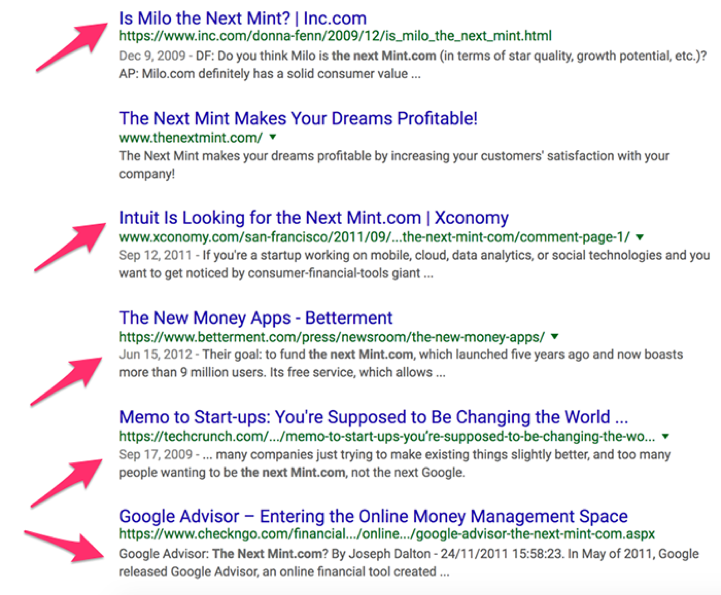
‘Free’ A/B testing
Organic marketing often highlights paid opportunities. For example, consider the mobile app space, where marketers can use an ASO tool to analyze the keywords their app is ranking for and how critical they are to success, or to judge the value of different customers based on the search keywords they used. Then marketers can take that organically-generated information and leverage it elsewhere.
“Now you can layer information into social buys, search buys, and mobile ad network buys,” TUNE’s Patrick Haig says.
A/B and multivariate testing isn’t limited to app store optimization, however. It’s also helpful in deciding which social messages to amplify.
Derrick Hayney, CEO of Vulpine Interactive, explains:
I can’t tell you the client, but they have a highly engaged social media page in the beauty industry. They would release videos that would get 30,000 views in a few hours. We were able to take their top performing posts, put $50 behind the post, and more than quadruple views, comments, shares, and engagements overall.Derrick Hayney, CEO of Vulpine Interactive
Social networks and content platforms have a built-in incentive to promote engaging content. Marketers can use that incentive, Hayney says, to get cost per view or cost per engagement down to fractions of a penny:
Paid traffic was able to extend the reach and keep the virality going, while organic shares was the main goal of the campaign and what drove a majority of the video views over the first few days of the campaign as it went viral. A good video should be getting about 50% organic to paid.Derrick Hayney, CEO of Vulpine Interactive
More signals, greater breadth
Organic placement has a big effect on consumer perception in web search as well, says Laura Simis of Coalmarch, a Raleigh, North Carolina-based agency:
Our analytics have shown that as mobile search has increased over the last 24 months, so has the number of same-day, repeat visits from potential leads,” she says. “These users are looking for an answer, but they’re not going to just pick the top choice that Google spits back at them. Many of them go looking for social proof or additional signals that the ad they were just shown is a reputable company. This is primarily where presence in the organic results can have a big impact on conversion.Laura Simis, Inbound Specialist at Coalmarch
Sandra Rand, VP of Marketing at OrionCKB, a marketing agency in Massachusetts, shares a related point of view:
Organic marketing efforts … add a layer of credibility — particularly earned media — when third parties position them in a positive light or give them a platform for thought leadership. So when audiences see an ad for something they may have seen on the Today Show or read about in Wired, they’re a bit more primed to pay attention to the ad than they may have been otherwise.Sandra Rand, VP of Marketing at OrionCKB
It’s also important to consider the role of traditional media in reinforcing impressions and helping elevate the value of digital. According to a 2015 Nielsen Global Trust survey, 66% of respondents said they trust earned media in the form of newspaper articles and editorial content, adds Hector Gonzalez, COO of branding agency MESH.
Even more people trust the recommendations and opinions of key influencers, according to personal branding consultant Talaya Waller of Waller & Company.
92% of people trust recommendations from other people, including brand ambassadors, advocates, thought leaders, and journalists … more than paid media. Organic media can be used to prove the validity of paid media.Talaya Waller, Personal Branding Consultant at Waller & Company
Larger segments of interest
For smart marketers, marketing equations are defined by a mixture of channels.
Sandra Rand, VP of Marketing at OrionCKB explains why: “Any organic traffic sent to the company’s website helps build retargeting audiences for paid advertising, and these can even be further segmented based on the pages they’ve viewed on that site or actions they’ve taken, such as adding an item to their cart,” she says.
Fully integrated, multi-channel marketers also invest in continual improvement. They know the value of their assets will diminish if they’re not refreshed or if attention to detail falters. For example: bad, spammy emails cause unsubscribes, tepid website content breeds apathy, irrelevant push notifications accelerate app uninstalls, and the list goes on.
On the flip side, high-quality content can become a competitive differentiator when cultivated across channels. Best-in-class marketing teams build every campaign, every ad, every promoted post, and every other form of paid and earned marketing to enhance and enrich owned platforms in addition to delivering immediate, specific, and ROI-driven goals. They don’t sacrifice, they supplement.
Eric Johnson, a marketer at FeedbackWrench, puts it nicely:
If paid marketing isn’t reinforced with organic marketing, the results from it will only ever be short-term. Organic marketing is like the second line on a hockey team. The first line is made up of the players who can score some quick wins, but the second line has to play strong once the first line’s energy has elapsed.Eric Johnson, Marketer at FeedbackWrench
Experiments and empirical evidence
Now that we’ve reviewed the theories of how and why this combination is better together, the key question is: Can all the organic and paid chatter from marketers be substantiated by data? Answer: Yes.
The following examples of combinations and results come from leading marketers around the world. We present them here to provide both evidence for the complementary nature of these elements as well as inspiration for marketers who want to conduct their own experiments with paid and organic.
Scientific observations: The effect of paid marketing on organic
-
Paid app installs can boost organic ASO 17-148%
Quality paid marketing benefits organic marketing in the app install space. On average, TUNE data shows that paid app installs boost organic downloads by 1.5X, and in some categories the boost is much much higher. Like balancing chemical equations, finding the perfect ratio for your paid and organic installs is a process of trial and error.
One example:
A major international travel company typically gets about 10,000 app installs each day on the iOS App Store. 90% of them are organic, and about 1,000 of them are paid. These organic installs, over time, are signalling factors to app stores that interesting things are happening with an app. That was the case for this company, and the results were explosive: app installs doubled with the same amount of paid user acquisition.
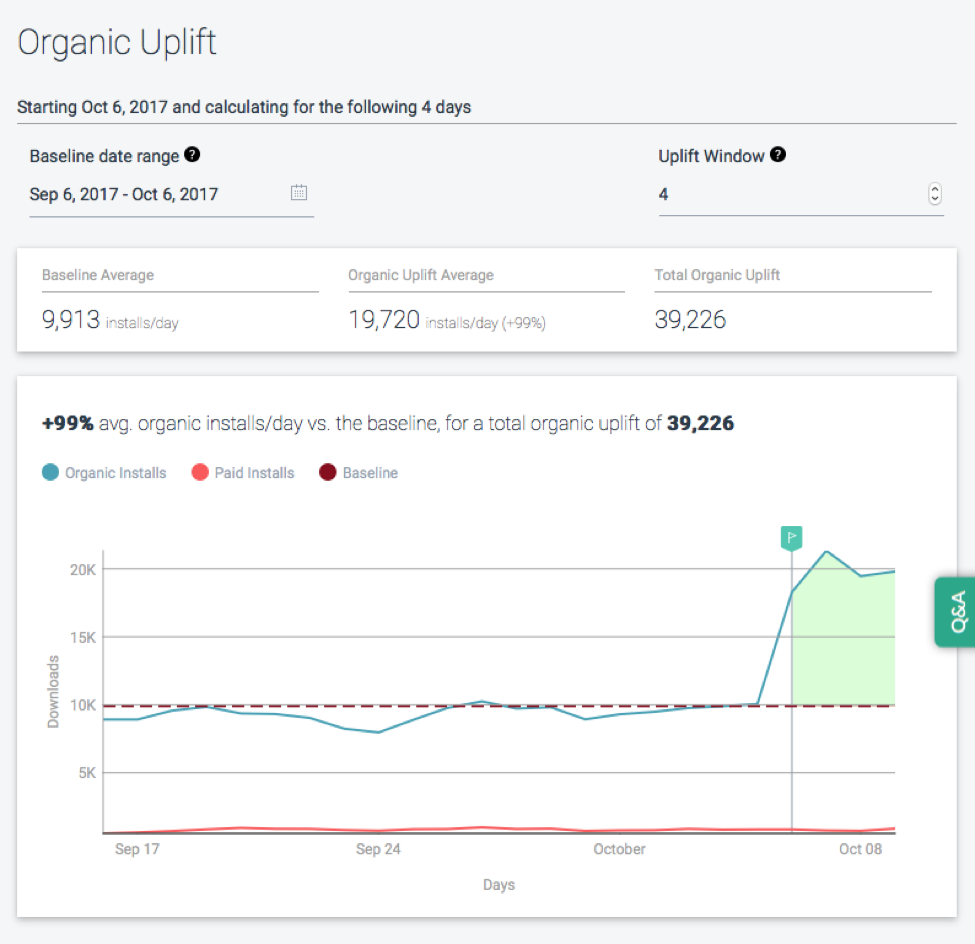
In another, a small increase in paid advertising led to a much larger spike in organic installs:
One TUNE customer that is a major e-commerce player typically gets about 10,000 installs per day on the iOS App Store: generally 25-50% paid, and 50-75% organic. Recently, the company increased its paid spend over a two-day period, which correlated with a 148% increase in organic installs over the following week. That’s a little over two times the organic installs per day for just 20% more paid installs.
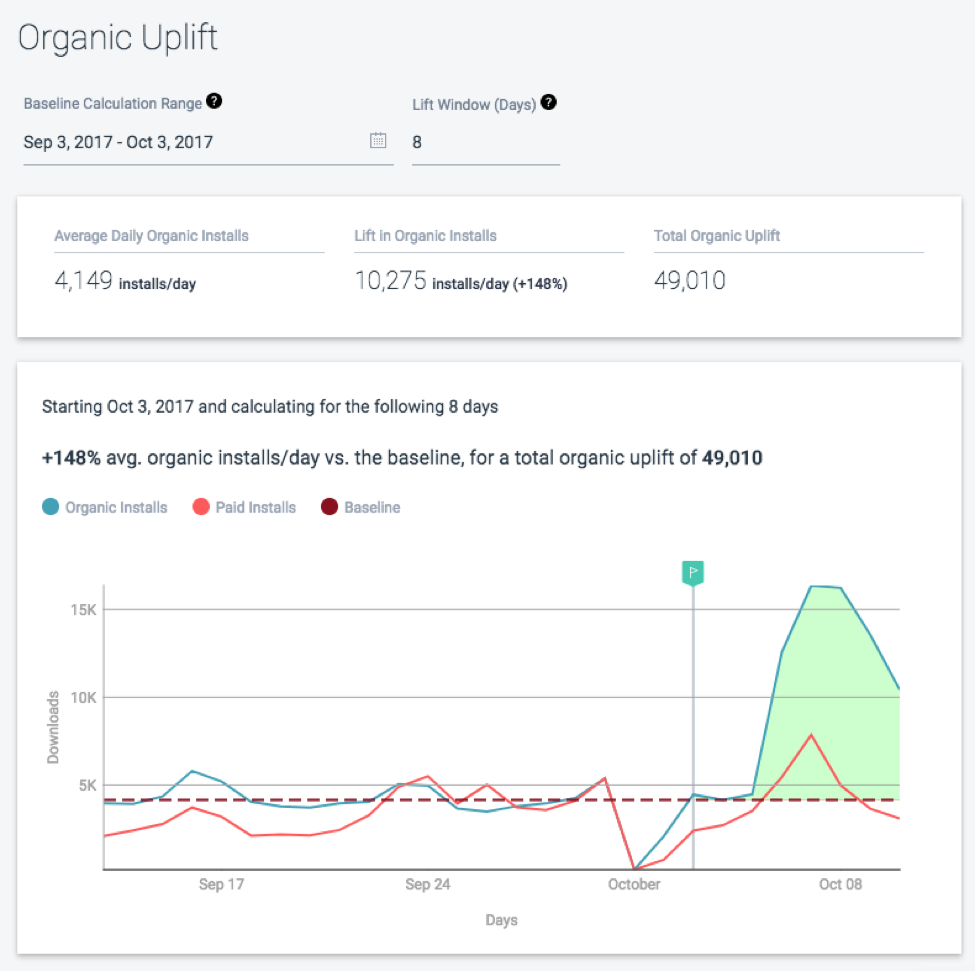
There’s also danger in paid, however:
One social app found an increase in paid over a number of weeks was accompanied by a dip in organic installs. A key reason: traffic quality.
TUNE Director of Product Patrick Haig elaborates:
Traffic quality is incredibly important in mobile app install campaigns. Poor quality paid traffic can result in app installs with very low engagement. Since engagement is one factor that the App Store and Google Play can take into account when organically ranking apps, only working with top quality ad partners can help ensure that your paid efforts don’t negatively affect your organic ranking.Patrick Haig, Director of Product at TUNE
This means that it is incredibly important to monitor your paid marketing campaigns. By measuring performance in almost real-time using quality attribution tools, you can combat poor quality traffic and optimize your time spent on offense.
One more example:
A media company was investing in poor quality paid traffic by buying app installs that showed day one retention of only 1-3%. (Good day one retention rates for organic traffic are in the neighborhood of 45-50%.) Shutting down that horrific paid marketing improved organic performance by 10%.
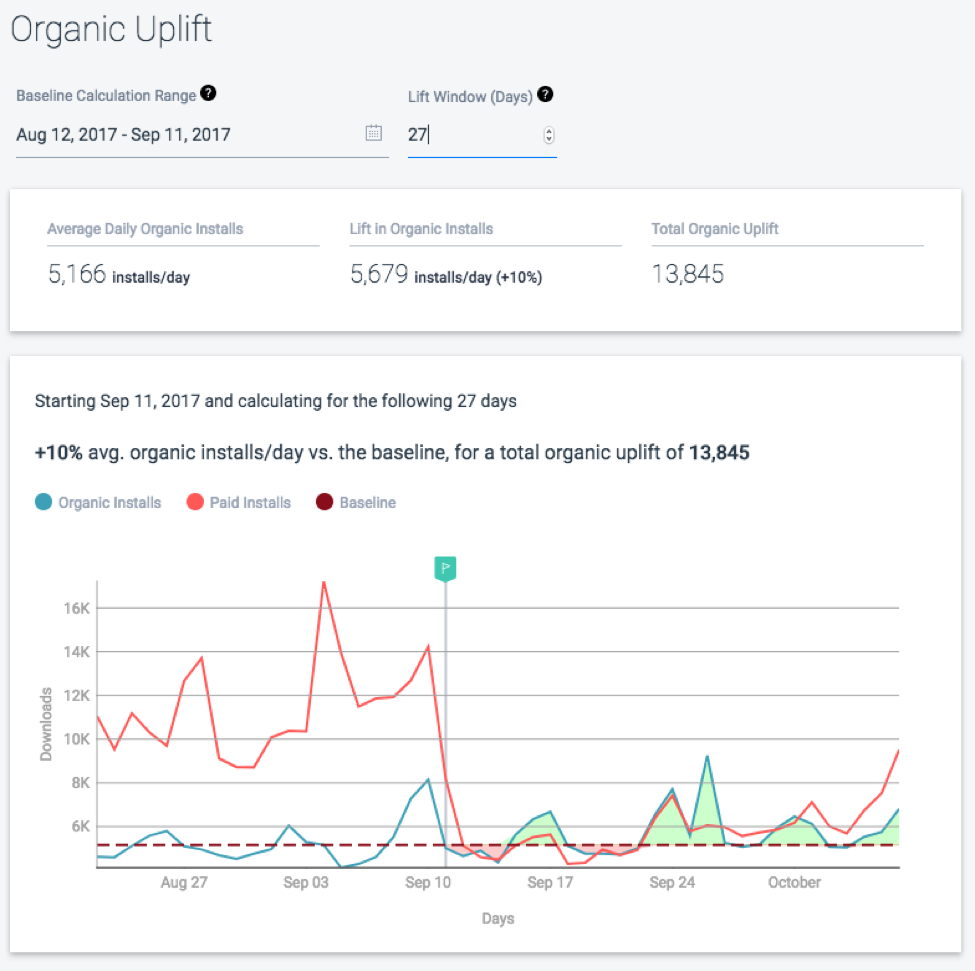
Earlier this year we published a case study that failed to gain any meaningful traction. Organic traffic to this post was far below average and conversions were practically non-existent. About a month ago we started testing Facebook Ads on a very limited basis. During that time conversions have skyrocketed and overall traffic to the post has also increased. While most of the increase was due to paid promotions, we’ve experienced a slight increase of around 15% in organic traffic.Stephen Jeske, Senior Content Strategist at CanIRank
That makes sense, because while the social ads are paid, people’s likes, retweets, and shares are earned. Both have an impact. As Ismael El-Qudsi, co-founder and CEO of Internet Republica says, “Earned media improves your reputation. You benefit from other people’s reputations if they retweet or repost your content.”
Results will vary in every experiment. And if you’re lucky, they’ll vary upward.
We launched a Facebook Ad campaign to promote a free trip giveaway. This has resulted in thousands of likes, shares, tweets and about 50 inbound links from travel blogs. Our organic search traffic has improved by 35% over the course of a couple of months because social shares and inbound links are major ranking factors in Google’s algorithm.Amine Rahal, Founder and CEO of Little Dragon Media
To recap, paid social led to earned social led to earned SEO led to owned web traffic. Additional examples of Better Together in action.
-
Paid SEM/PPC can boost organic SEO 10-39%
Just as apps can lead to deeper engagement and higher business value, so too mobile and desktop web is a central component of any broad funnel approach to customer acquisition. And another laboratory for organic and paid marketing.
We will often digest which keywords from a paid advertising effort performed the best, and modify our own content such that the content on our pages matches appropriately, to enhance our organic marketing efforts.Joshua Weiss, CEO of TeliApp
I target 15 keywords in my pay-per-click campaigns and one of them is converting like crazy, so I target that one keyword through my organic SEO efforts. It will take a few months to see how much my organic targeting efforts will pay off, but at least now I know which word to target with my SEO.Rafael Romis, Founder and CEO of Weberous
On average, we’ve seen a 10 to 20% lift in organic search traffic for keywords and phrases where ads are also placed, particularly around branded search. Those ads are also very affordable and perform well, as they are typically lower cost.Kent Lewis, Founder and President of Anvil
Why does this work?
Laura Simis of marketing agency Coalmarch notes that since page traffic is a factor in SERP ranking, boosting traffic to a specific page via paid media can improve that page’s ranking. The inverse is also true: reducing paid campaign spend can have negative repercussions for organic rankings.
Ryder Meehan, Principal at Meehan Digital in San Francisco, explains this relationship through a test he ran for a major genealogy site:
In an effort to reduce marketing costs, there was an effort to test pausing ads on keywords where we already ranked number one organically. Overnight there was a 15% decrease in spend but also a 22% decrease in sales. Total conversion rate fell by 20%. As soon as we re-activated the paused keywords, our conversion rate bounced back by the same 20% as before the test.Ryder Meehan, Principal at Meehan Digital
Meehan adds that usually these synergies are harder to measure, since brands are generally afraid to turn off the paid spigot, or aren’t running paid in the first case. In this scenario, he captured vital data by turning paid ads off, and saw the proof of the relationship in what happened when he reversed that action.
Michael Bates at We Are Boutique saw a similar effect:
When a client reduced their PPC budgets following the launch period, the number of sessions through the PPC channel fell by 62%. We also saw a 33% decrease in the number of returning visitors to the site via other channels, despite organic rankings remaining steady and site content remaining substantially the same. As PPC budgets were reallocated, and campaigns optimized to target early-stage research queries, we saw returning users to the site increasing once again, and overall site revenue increases. Organic conversion rates increased by 74% month on month, and revenue increased 39% as the percentage of returning users to site was once again improved.Michael Bates, Organic Search Executive at We Are Boutique
This isn’t a reaction that only small brands and boutique agencies experience. Billion-dollar brands are seeing similar results.
Ismael El-Qudsi, co-founder and CEO of Internet Republica, expands on the theme:
We have aligned SEO and SEM strategies for several big clients and we have seen uplifts of 20 to 25% with the same budget. These clients are DIA, El Corte Inglés, and Vodafone, and their SEM budgets are usually more than $1 million dollars per year.Ismael El-Qudsi, Co-Founder and CEO of Internet Republica
The kicker is that Google itself agrees: “… a meta-analysis of 390 search ads pause studies highlights the limited opportunity for clicks from organic search results to substitute for ad clicks when the ads are turned off.”
Translation: You’re better off with ads even if you have high organic rankings. Also of note is that better SEO makes for better click-through rates.
Any time I’ve done a SERP real estate analysis, which measures the click-through rates when you’re present in both paid and organic search to those where you’re present in only one, it yields the same insights. When present in both organic and paid search results, the click-through rates and subsequent traffic for both increases.Julie Howell, SEO Director at Postali
Working in the notoriously difficult medical field, he fused an SEO and PPC campaign together in a six-month test. The result? “We noticed there was a 2X increase in inquiries when we pushed both SEO and PPC versus SEO alone.Tom La Vecchia, Digital Marketer, Publisher of the New Theory marketing podcast
With many inorganic methods such as Google AdWords getting extremely pricey, at least for our line of work, we’ve looked at Pinterest for a cheaper and more effective way of inorganic advertising. We’ve had over 50,000 impressions, mostly on mobile, for around $100, and have seen our organic traffic pick up tremendously. To be more specific, we had around 10 searches a day for our new name, and that number has gone to around 100 a day since our Pinterest campaign.Amy Nedross, Director at Monday Loves You
Sandra Rand, VP of Marketing at OrionCKB, found that this process of exploration can drive “free” leads, also known as non-directly-attributable leads because they show up concurrent with spend in a very different area.
Rand describes her experience with the client, a for-profit educational institution:
“We did find that for every $50,000 they spent on Facebook advertising, we generated an additional 205 direct or organic leads for them from SEO and direct traffic sources.”
In essence, brand advertising is also performance advertising, and vice versa.
Scientific observations: The effect of organic marketing on paid
-
Organic SEO plus paid PPC can boost revenue 30%
Breakthrough marketing is driven by new connection points. One example is the point where organic SEO combines with paid PPC.
Whilst managing a PPC campaign for a leading client in 2016 our team ran paid advertisements through keywords that the company already ranked well for organically. This strategy proved extremely effective, emphasizing the idea that this particular client was more prominent in the market than their competitors, and therefore more credible. Due to this, the total revenue through both organic and paid search increased by 30% compared to the previous year.Lauren Beales, Account Executive at Haystack Digital
The company appeared both in ads and on the first page of search results, effectively doubling its visibility, which increased revenue by almost one third. Not too shabby.
Jason Dodge, founder of Black Truck Media, found that combining SEM and SEO results in increased brand recognition:
When a user performs a search, the top results they see are an ad, followed by those sites ranked organically. Depending on the search, the ad creative, and the user, he or she may not click on the ad. Instead, they might scroll down. Once that user sees your website in the organic results, the likelihood of them clicking on it is much greater due to brand recognition as they already have your brand name in their minds from the top of the page.Jason Dodge, Founder of Black Truck Media
Oeuyown Kim at Workshop Digital cites research that tested the relationship between organic SEO and paid PPC and found almost a 30% lift: “When a brand name appears in both organic and paid search results for the same query, the brand attracted 92% of total clicks. When the brand name was mentioned only in organic results, the brand got 60% of clicks.”
-
Organic SEO plus paid retargeting ads can boost sales 22%
Sometimes all it takes to force a reaction is turning up the heat. For marketing leaders, that translates to enhancing owned assets with paid to drive more of what’s already working.
Five years ago we started working with organic marketing through search engine positioning thanks to content marketing. The traffic that we obtained through this mechanism represented 77.4% of our sales to new customers. Two years ago we took advantage of this traffic and started doing remarketing work through Google AdSense and Facebook Ads. This allowed us excellent segmentation thanks to the use of organic traffic that we now also achieve in paid advertising through remarketing.Cristian Rennella, CEO of elMejorTrato
The result? A 21.9% increase in revenue and, according to Rennella, the best marketing strategy move he’s made in the last few years.
-
Organic SEO plus paid SEM/Shopping ads can boost revenue 800%
We’ve found that marketers who don’t seek and exploit synergies between paid and organic marketing channels often shortchange their ROI.
Alison Garrison, a senior director of marketing at Volusion, an e-commerce platform for SMBs, saw a long 12 months’ worth of organic search engine optimization pay off when she added Google Shopping ads.
After kicking off a Shopping feeds campaign, the SEO work that had been going for about a year gained significant traction, and traffic from organic search increased 325% overall and more than 400% from mobile alone year-over-year.Alison Garrison, Senior Director of Marketing at Volusion
As if 400% growth weren’t enough, the most impressive result Garrison experienced was that revenue jumped through the roof, including revenue attributed to organic search: “Revenue from organic search increased by 240% during that period. Shopping feeds ads were key to success here — overall traffic increased by more than 2,500%, mobile traffic increased by more than 10,000%, revenue increased by more than 800%, mobile revenue increased by more than 80,000% — not a typo.”
Though the results above reflect a low starting point of web and website revenue, the results are nonetheless impressive.
-
Organic relationship management can boost paid SEM/PPC click-through rate 25%
An under-appreciated strategy is that focusing on reputation can not only boost your brand, but also improve your click-through rate on paid search ads.
We did some ORM for a client in Boston who sells medical equipment. This resulted in an overall score of 4.8 stars out of 5. We were then able to add the reviews as an ‘ad extension’ on our Google Adwords ads, which improved click-through rate on our ads by over 25%.Amine Rahal, Founder and CEO of Little Dragon Media
A good score can have notable reputation benefits, improved organic search placement and click-through rates, and even improved conversion rates when potential customers arrive at your website. When applied to paid search activities, this investment can yield even higher returns.
For two different clients of ours, one an insurance franchisee and another a home goods manufacturer and distributor, we noticed that posting about current events that are related to their products works better than merely posting about the product itself. The supporting data was overwhelming, and so we modified both their respective organic and paid search campaigns. For one client, we increased their Facebook page following by nearly 1,900%, and their corresponding website traffic by over 1,000% over the same three-day period.Joshua Weiss, CEO of TeliApp
One client saw a branding video — one that was not product-focused or with a strong call to action to buy — really get traction on Facebook organically. It resonated because it hit people at an emotional level and sold them into the importance of the company’s mission. Once we put some paid social budget behind it, it took off and sales followed.Sandra Rand, VP of Marketing at OrionCKB
Sales followed, just as ad costs fell and return on ad spend jumped: “This approach, using a video intended for organic as an ad, reduced cost-per-action by 3.6% and increased return on ad spend by 24%. With the increased level of volume, we were also able to increase the number of purchases driven by Facebook 680%!”
If there were two Facebook pages selling the same exact product, yet one page had 15 likes and the other page had 15,000 likes, which page would you buy from? We have found that the more followers that we have, the more engagement we have, and the more optimized we can make our social media channels, the more our organic and paid reach compliment each other.Tucker Ferwerda, Facebook Ads Specialist at Zero to Hero
The question is: By how much?
According to Ferwerda: “Organic traffic, especially when it’s hyperactive, completes the marketing efforts. Our Instagram accounts that are above 10,000 followers work better and get better conversions than the pages just starting out by at least 50%.”
The longer someone follows, the more valuable they tend to be. He adds, “That’s because they are followers, have been around the block longer, and have trusted our brands. Organic traffic converts better!”
It’s important to understand what Ferwerda means by “hyperactive.” He’s talking about authentic social engagement. Not shockingly, that can be accelerated by paid.
Ferwerda explains: “Let’s say a mom sees an ad about how to raise her kids the right way, she’s interested, and the first thing she does is check out the page. If the page has 2 million followers on Facebook, it automatically establishes in her mind trust because others are checking them out too. If she sees that there are a lot of comments and shares, she’s hooked.”
Again, keep in mind the nature of experiments and replicability: results may vary. Just because one brand achieves a 50% sales lift from organic social does not mean the same results are guaranteed for everyone. But with attention to detail and a willingness to experiment, refine, and replicate, the synergistic benefits of paid and organic can be yours.
Tried-and-tested tools
Now that we’ve looked at the science of mobile marketing, identified synergies between paid and organic channels, and shared examples of the benefits that the combination can drive, only one question remains.
How do you start optimizing ROI with paid and organic marketing?
Make all marketing measurable
Leading marketers know that attribution is at the core of their data-driven needs. Though attribution can seem complex and challenging, the central concepts are straightforward. In summary, attribution
- Highlights how prospects become customers
- Delivers insights on customer buying patterns, helping increase advertisers’ share of wallet
- Shows how valuable customers become avid fans
- Illustrates how fans advocate the good news about you, your company, your products, and your brand
Without attribution, marketers don’t know what’s working and struggle to make effective decisions. To truly understand how organic and paid marketing channels interact, effectively experiment with combinations of the two, and take advantage of the resulting synergy, you need the right set of tools.
Here are a few that matter.
Attribution tools
Marketers must have attribution. It’s the foundation of strategy and success in the mobile era.
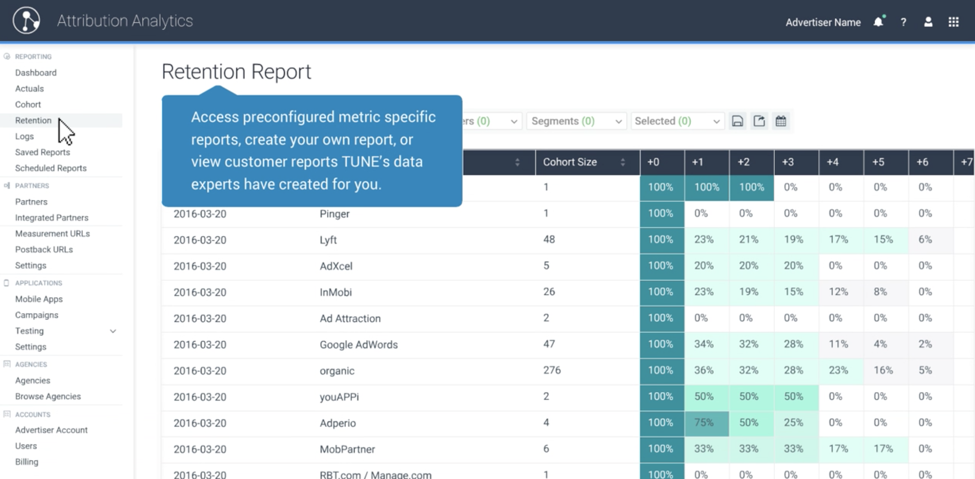
Attribution data can be collected in multiple ways, the central requirement being that it’s people-based rather than device-based. This means that any activity your potential customer undertakes — whether on the web, in-app, in person, or via another channel — is attached to the person behind the action instead of the smartphone, laptop, or other device they used. TUNE’s Attribution Analytics is a great example.
Organic analytics tools
Marketers focused on building their owned channels need to understand how successfully they’re working with those platforms to generate organic buzz and business. App Store Analytics does just that.
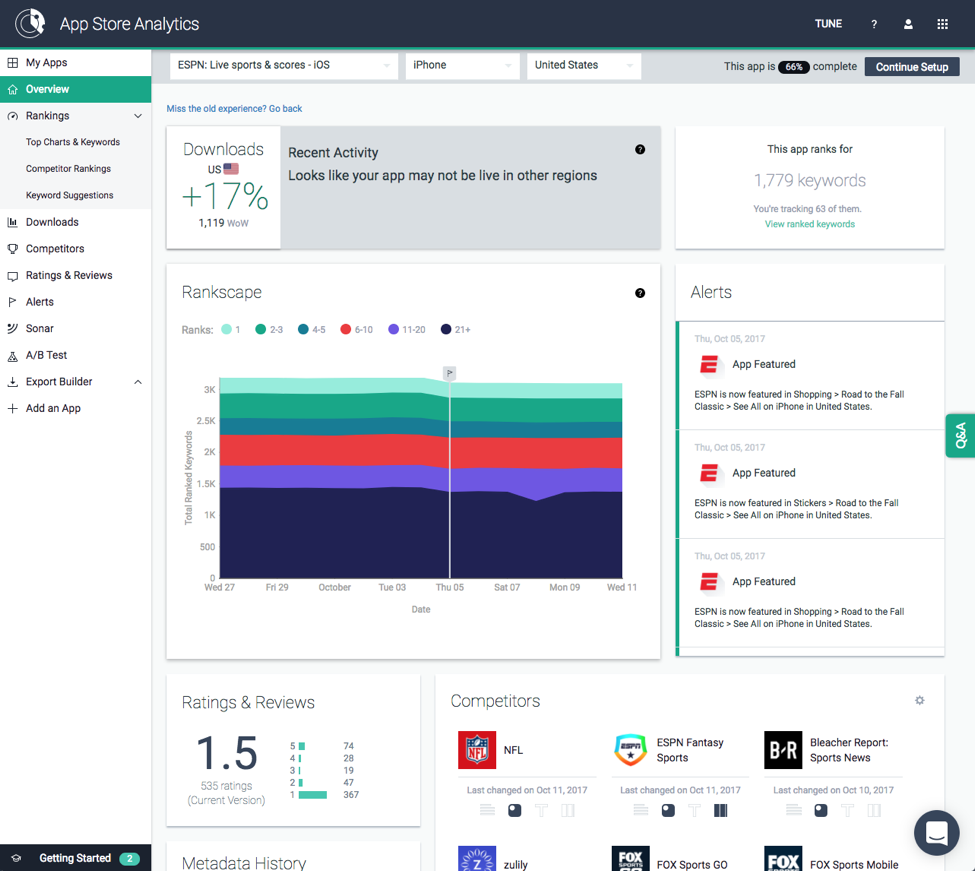
Ideally, your organic analytics tool does more than report data. It should suggest and enable optimization strategies to improve earned and owned results. It should also be hooked directly into a marketer’s attribution engine so they can compare organic and paid performance side-by-side, as well as observe how optimizing owned media results in additional performance lift.
Owned engagement tools
Tools that enable easy engagement with owned audiences are essential, especially for modern channels with extensive two-way feedback. Apps are one example, as are messaging bots and websites with support chat channels.
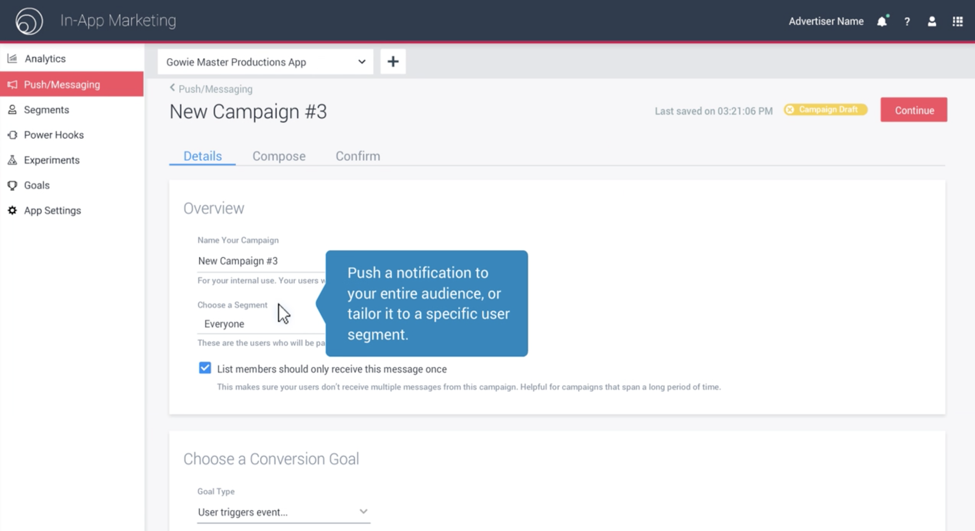
Marketers need mechanisms like In-App Marketing that give them the ability to nurture and communicate with customers and communities in their owned outposts. These tools are most effective when fully integrated into your attribution and organic analytics systems.
Paid optimization tools
Optimizing Facebook ads is easy. The same is true for Google ads with on-platform tools. But how do marketers know whether to spend more on Google, or Facebook, or sponsoring an email list, or holding an event, or airing a TV commercial?
They need tools that allow them to compare ROAS across platforms and partners.
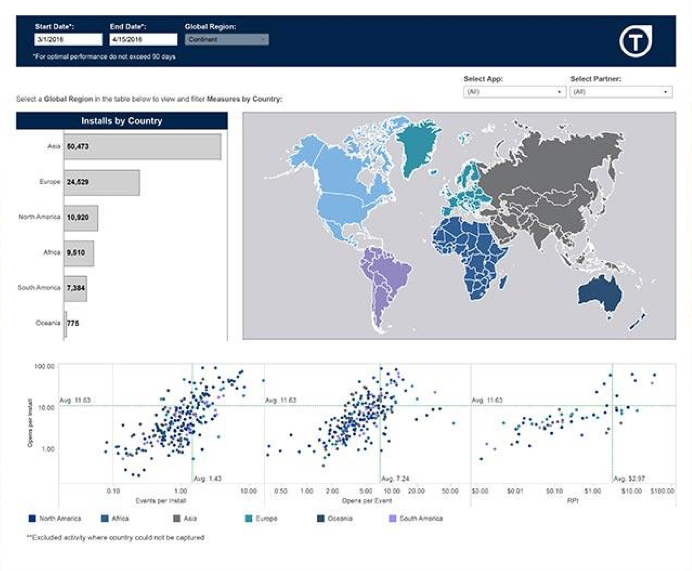
Only by integrating both structured and unstructured data from dozens (if not hundreds) of ad partners can you see normalized return on ad spend, which you can use to make bigger strategic allocation decisions, rather than narrow, platform-by-platform choices.
Conclusion
In this report, we’ve covered the strategies and science of paid and organic mobile marketing. We’ve explored the synergistic bonds these elements create along with real-world applications for their use. And we’ve examined tested combinations in the hope that some will prove applicable to your business.
The complexity of the modern marketing ecosystem and the abundance of choices marketers must identify and make require perspectives that are broader and deeper than ever before. As many TUNE customers have learned, the better together of paid and organic marketing is just the start.
Stay tuned for additional insights on how these principles also apply elsewhere in customer acquisition and retention, and how marketing leaders are making Better Together work for them.
Report updates:
If you have interesting data on paid and organic combinations that you would like to share, please contact us at [email protected] and we’ll consider it for inclusion in a future update.
Important note:
All data contained in this report is aggregated and anonymous. References are provided for informational purposes only and TUNE makes no representations as to accuracy, completeness or timeliness, and disclaims any liability or responsibility to any third parties based on the use of this report. All opinions reflect judgments made as of the original date of publication.
Meet the Author:
Let’s chat! I’ll be presenting Better Together and answering your questions via Facebook Live on January 17th. How are you making paid and organic work for your business?
Register Now
